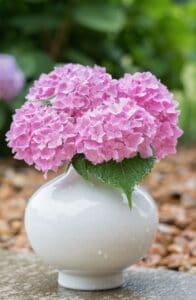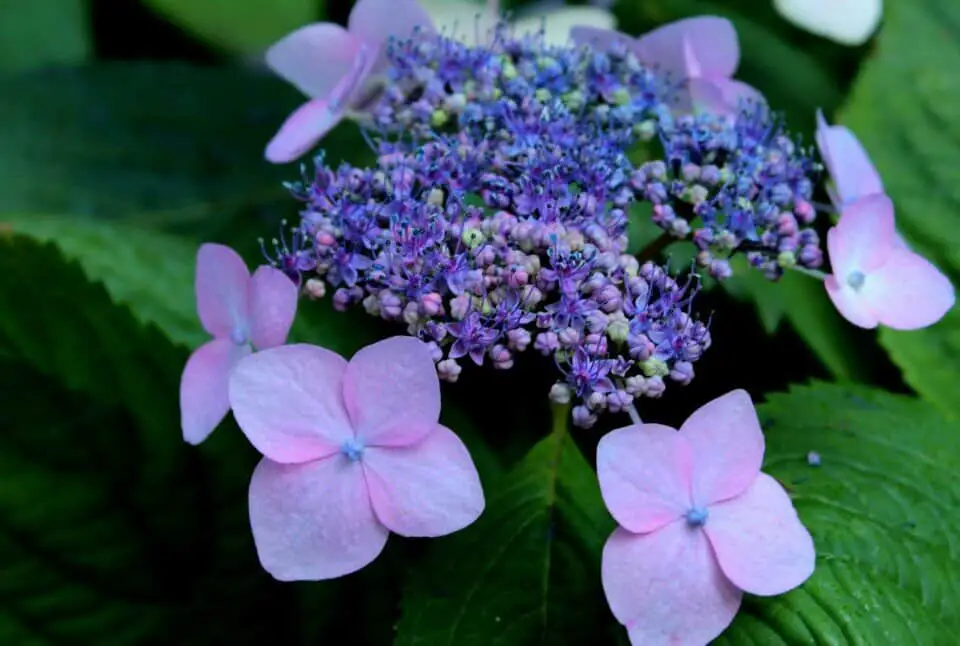Some links in the post are affiliate links and I get a commission from purchases made through some links found in the post.
Hydrangeas are amazing flowering shrubs that can make any garden look more welcoming and aesthetically beautiful. It is impossible to look at them and not get amazed by their delicate, huge blooms.
The hydrangeas are generally very easy to maintain once they are established. However, sometimes, they may not like something and as a result, your hydrangea will start wilting.
There may be various reasons behind your hydrangea wilting. The main reasons behind your hydrangea wilting are overfertilizing, direct sunlight, underwatering, overwatering and transplant shock.
When you notice your hydrangea wilting, first of all, it is important to find the proper cause and then start looking for solutions.
No worries, in this article, we will discuss possible causes of your hydrangea wilting and will also teach you how to help your beloved green friends.
Why is your Hydrangea Wilting
Generally, it is hard to tell right away why is your hydrangea wilting. Typically, the plant hydrangea is not very susceptible to pests and diseases, therefore, this rarely is the case.
However, this plant is extremely sensitive to the physical aspects of its growth environment, such as the amount of light, temperature swings, moisture availability, and soil acidity.
Let’s discuss several reasons why maybe your hydrangea may be wilting and explore the possible solutions.
1) Overfertilizing
 The wilting of hydrangea plants might result from overfertilizing. For sure, you feed your plant with the best intentions. Yet, if done too early, or if given too much, hydrangeas most likely will respond by wilting their leaves and foliage.
The wilting of hydrangea plants might result from overfertilizing. For sure, you feed your plant with the best intentions. Yet, if done too early, or if given too much, hydrangeas most likely will respond by wilting their leaves and foliage.
Overfertilized hydrangeas will start to wilt their bottom leaves. This is mostly caused by an excess of soluble salts in the dirt that prevent water from reaching the roots.
The root system becomes stressed as a result. Overfertilization with too much salt also raises the pH of the soil, which kills certain beneficial bacteria.
If this happens, your hydrangea has a possibility to develop illnesses brought on by infections.
If your hydrangea is wilting, and you notice overfertilization on time, then the plant can be saved. First of all, what you can do is try to remove the part of fertilizer manually which can be seen with the naked eye on top of the soil.
After that, What you can do is start “flooding” the garden. Add as much water to the soil as possible. Long and deep watering may take the fertilizers to the deeper surfaces and not harm the roots that much.
However, when flushing, make sure that you are not creating the puddles of water. So, once you notice the soil getting very soggy, stop watering.
Then repeat this process every few days. Additionally, make sure to remove any damaged foliage from the plant itself.
If you have a hydrangea in the pot, you can pour water into the pot, then let it drain fully to remove any extra fertilizer.
To avoid overfertilization in the future, remember that hydrangeas should be fertilized twice a year, at the beginning of spring and the early summer.
When the plants first begin to leaf out in May, you can give them additional food. The second round is during the growing season, which starts around July.
It is important to make sure you are giving it the proper fertilizer and on time.
2) Direct Sunlight
Hydrangeas prefer to be placed in partial shade. However, if they are planted in the direct sun, and the temperature outside is high during summer, then this may be the cause of your hydrangea wilting.
It’s crucial to place your plant in some shade or to provide the hydrangea shade after planting because they tend to wilt in broad light.
For the best combination of enough sun to stimulate blossoms but not too much sun that the hydrangea is in danger of withering, place your hydrangea in the spot where it will get the morning sun and be shaded rest of the day.
The perfect location is beneath the tall tree. If you have a hydrangea in the direct sunlight, then it is recommended to be relocated.
3) Underwatering
It’s possible that your hydrangea wilting is because of the lack of water. These plants thrive best in damp soils and a muggy environment that is occasionally misted.
Your hydrangea plant might get dehydrated due to dry conditions, crusty soil that cannot absorb water for an extended period of time, and erratic watering regimens.
Lack of water will make it necessary for the roots to work harder to take water from the soil. Because of this, roots go through stress, which impairs their capacity to operate normally.
The plant limps and may even die in conditions of extended dryness.

Another reason for hydrangea wilting may be overwatering. water is essential for a hydrangea’s survival. It is crucial for the operation of several physiological functions.
Improve the moisture retention of your soil by adding organic matter. Compost may add nutrients to your garden soil and help your plants feel less thirsty.
For your hydrangea plant, balance the hours of light and shade. The stomata of your plant may lose water unnecessarily as a result of prolonged exposure to sunlight and heat.
On days when it’s hotter, use more water. Naturally, plants have a greater thirst in hot weather than in cold weather. Keep in mind to provide additional water when the hydrangea requests it.
Your hydrangea plant may require a change in watering routine to help it fight withering and dehydration.
To avoid overwatering your plant and causing root rot, it is a good idea to often heck topsoil to see if it is dry before watering.
4) Overwatering
Any plant that lacks water will express it by wilting. The same outcome can occur if there is too much of it.
When a plant is overwatered, it is forced to consume more water than it can handle. When this happens, both old and new foliage will start to wilt.
First of all, to save the overwatered hydrangea, you must stop watering the plant temporarily. Additionally, you can make the soil loosen around the plant. Also, you need to make sure that there is no root rot started.
The most important signs of how often to water your plants are the amount of sunshine your hydrangea receives and the soil it is planted in.
Sandier soils with adequate drainage need to be watered more frequently than clay soils that have poor drainage and retain moisture.
It is recommended to water your hydrangeas weekly. This way, the soil maintains it at a constant moisture level should be adequate if your hydrangeas are kept in a place with well-drained soil, some sun exposure, and wind protection.
When you stick your finger into the soil, if it seems dry to the touch then you can give it some more water. Your hydrangeas will thrive with less frequent, deeper watering.
5) Transplant Shock
If you just recently replanted your hydrangea, it is natural for it to wilt.
This happens Due to transplant shock, which results from a discrepancy between the growth circumstances at the garden center or nursery where the hydrangea was originally cultivated and the particular conditions in your garden.
The hydrangea may have been cultivated under extremely particular conditions in a temperature-controlled greenhouse, so it may take some time for it to become used to the garden soil and stop drooping leaves.
The hydrangea wilting is normal during this period as it loses more water than it would generally do. The roots of your hydrangeas can take some time to establish in the soil.
It’s crucial to shield newly planted hydrangeas from harsh sunlight for them to get adjusted better. At this time of planting, some sunshine is helpful for promoting blossoms, but it is likely to make the soil and leaves dry up and droop.
For around three weeks, provide provisional shade for freshly planted hydrangeas as they establish themselves.
If you want to avoid newly planted hydrangea wilting, then take some precautions from the very beginning. When transplanting your hydrangea, handle it with great caution
When you remove the roots from the dirt, be careful not to harm them. Shaking off some of the extra soil is a gentle way to remove it. Cut out any extra or broken roots as needed is recommended.
To keep the soil wet and protect it from direct sunshine, give it a thorough soak and apply mulch to the top of the soil surrounding the hydrangea.
Water as often as necessary, typically, three times a week to keep the soil wet, but watch out that the soil doesn’t get soggy since this could lead to other issues like root rot.
As long as the soil is moist and you have shielded the planet from the sun, depending on how dehydrated your hydrangea is, hydrangea can take up to a few days to recover.
Final Thoughts
 Many different factors and changes in the conditions can result in hydrangea wilting. However, after caring for it accordingly, hydrangea typically will be cured without much difficulty.
Many different factors and changes in the conditions can result in hydrangea wilting. However, after caring for it accordingly, hydrangea typically will be cured without much difficulty.
In such situations, it is essential to find the problem and act quickly. Generally, hydrangea wilting can be caused by overwatering, underwatering, overfertilization, Direct sunlight exposure, or transplant shock.
Always monitor the plant’s reaction to your intervention. In most cases, only a little help can fix the problem however, in some cases, the situation can be serious. The state and extent of the damage can determine everything.


